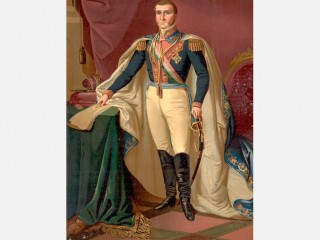
Agustín De Iturbide biography
Date of birth : 1783-09-27
Date of death : 1824-07-19
Birthplace : Valladolid, Mexico
Nationality : Mexican
Category : Historian personalities
Last modified : 2010-11-10
Credited as : Military leader, army general,
Agustin de Iturbide (1783-1824) was a conservative military leader who won Mexican independence from Spain and then ruled as Emperor Agustin I in 1822-1823.
The Mexican independence movement is distinguished sharply from its counterparts in South America by its two separate phases. The initial revolt, led by Father Miguel Hidalgo, was liberally oriented but went far beyond the South American liberals by its inclusion of the mestizo (mixed-blood) and Indian classes, which gave it an overtone of social revolution. The Creole aristocrats (white American-born individuals of Spanish descent) defeated the rebels but themselves sought independence in a second phase, under the leadership of Agustin de Iturbide.
Iturbide was born in Valladolid (now Morelia), Mexico, on Sept. 27, 1783, the scion of a wealthy, staunchly Catholic, aristocratic family of Basque descent. He received his education at the seminary in Valladolid and devoted his youth to managing one of his father's haciendas (estates). In 1805 he married Ana Maraia Huarte, daughter of the provincial intendant (governor).
Iturbide received a commission in the royal militia and quickly gained fame for his daring actions during the campaigns against the liberal revolutionaries. Employing imaginative stratagems and stern measures, he acquired a reputation for bravery and harshness, earning several promotions. By 1813 he held the rank of colonel, commanding the Celaya regiment in addition to serving as military commandant of the intendancy of Guanajuato. Two years later he was placed in charge of the Army of the North, whose jurisdiction encompassed the intendancies of Valladolid and Guanajuato.
Iturbide was among the young Creole aristocrats who began to contemplate the possibility of separation from Spain in response to an 1820 military revolt which placed Spain under a liberal regime. Iturbide was then commanding royal forces pursuing Vicente Guerrero, one of the few liberal revolutionaries still in the field. The two entered into negotiations, and Guerrero pledged his support to his former adversary.
On Feb. 24, 1821, Iturbide launched his own revolt by issuing the Plan of Iguala, also known as the Triguarantine Plan. His 23-article statement spelled out a conservative program based on three guarantees: religion, independence, and union. These terms indicated that Iturbide was dedicated to preserving the colonial system, merely substituting Creoles for Spaniards in governmental posts. He aspired to constitute Mexico into an independent monarchy, headed by a Bourbon prince, while preserving class and Church privileges.
Much of the Creole populace rallied to Iturbide's support. When Capt. Gen. Juan O'Donojo arrived to assume his duties as the new Spanish viceroy in Mexico a few months later, he found Iturbide in effective control of the country. Lacking sufficient forces to challenge the Mexican leader's ascendancy, the viceroy proposed negotiations. The resulting Treaty of Cordova confirmed Mexican independence under a Bourbon prince and stipulated that, pending selection of a monarch, Mexico would be governed by a junta headed by Iturbide and including O'Donojo in its membership. Iturbide, the "Liberator," rode triumphantly into Mexico City at the head of his army on his thirty-eighth birthday, Sept. 27, 1821.
When members of the Spanish royal family spurned the proffered Mexican throne, Creole sentiment turned toward investing Iturbide with the honor. On May 18, 1822, a sergeant in Iturbide's own Celaya regiment launched a "popular" movement to proclaim Iturbide emperor. The Liberator exhibited a proper degree of reluctance, but the next day Congress, with tumultuous crowds of Iturbide's adherents jamming the hall, formally selected him as emperor. Lack of a quorum cast doubt upon the legality of this mandate, but the action had considerable popular support.
Iturbide was crowned Emperor Agustin I on July 21, 1822, amid elaborate pageantry. The new monarch presented an imposing figure in his regal robes. At 5 feet 10 inches, he was taller than his Mexican contemporaries, and his erect, military bearing and aloof, aristocratic manner added to the aura of imperial splendor.
Iturbide devoted considerable effort to creating an elaborate court, attempting to match the magnificence and pomp of European royalty. He also endeavored to secure the traditional prerogatives of the Spanish crown, attempting to assert his right to appoint Church officials as well as civil administrators. Also, even prior to assuming the imperial title, he had initiated preparations for extending Mexican sovereignty southward, and in December 1821 he had dispatched an army to Central America in a futile attempt at annexation.
Iturbide proved to be a tactless ruler, and his regime was characterized by constant disputes with the legislature, which challenged his efforts to concentrate power in his own hands. After imprisoning several of the deputies, the Emperor dissolved Congress on Oct. 31, 1822. Iturbide had already forfeited much of his initial popularity, and a rebellion soon broke out.
On March 19, 1823, Iturbide abdicated and shortly thereafter departed for Europe, where he became alarmed at reports of an impending Spanish expedition against Mexico. Convinced that only he could save his homeland, he offered to "place his sword" at the nation's disposal. Interpreting this as an attempt to regain power, the Mexican Congress declared him a traitor and sentenced him to death. Iturbide sailed for Mexico before learning of this decree and was arrested upon landing at Soto la Marina in the province of Tamaulipas. On July 19, 1824, the Liberator of Mexico, thoroughly discredited by his actions while occupying the throne, was executed by a firing squad.
The best work on Iturbide is William Spence Robertson, Iturbide of Mexico (1952). For a briefer account see Robertson's Rise of the Spanish-American Republics, as Told in the Lives of Their Liberators (1918).
















